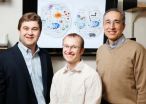(Press-News.org) Currently, some 20 percent of the world's industrial production is based on catalysts — molecules that can quicken the pace of chemical reactions by factors of billions. Oil, pharmaceuticals, plastics and countless other products are made by catalysts.
Many are hoping to make current catalysts more efficient, resulting in less energy consumption and less pollution. Highly active and selective nanocatalysts, for example, can be used effectively in efforts to break down pollution, create hydrogen fuel cells, store hydrogen and synthesize fine chemicals. The challenge to date has been developing a method for producing nanocatalysts in a controlled, predictable way.
In a move in this direction, Yu Huang, an assistant professor of materials science and engineering at the UCLA Henry Samueli School of Engineering and Applied Science, and her research team have proposed and demonstrated a new approach to producing nanocrystals with predictable shapes by utilizing surfactants, biomolecules that can bind selectively to certain facets of the crystals' exposed surfaces.
Their new study can be found online in the journal Nature Chemistry.
At the nanoscale, the physical and chemical properties of materials depend on the materials' size and shape. The ultimate goal has been to rationally engineer materials to achieve programmable structures and predictable properties, thereby producing the desired functions. Yet shaped nanocrystals are still generally synthesized by trial-and-error, using non-specific molecules as surfactants — a result of the inability to find appropriate molecules to control crystal formation.
Huang's team's innovative new work could change that, potentially leading to the ability to rationally produce nanocatalysts with desired shapes and, hence, catalytic properties.
"In our study, we were able to identify specific biomolecules — peptide sequences, in our case — which can recognize a desired crystal surface and produce nanocrystals exposed with a particular surface to control the shape," said Chin-Yi Chiu, a UCLA Engineering graduate student and lead author of the study.
"Facet-specific biomolecules can be used to direct the growth of nanocrystals, and most importantly, now we can do it in a predictable fashion," said Huang, senior author of the study. "This is still a first step, but we have overcome the challenges by finding the most specific and selective peptide sequences through a rational selection process."
Huang's team accomplished this by using a phage library that generated a pool of peptide sequences. The team was then able to identify the selectivity of peptide sequences on different crystal surfaces. The next step, the researchers say, is to figure out what exactly is happening on the interface and to be able to describe the characterizations of the interface.
"We don't know the molecular details yet — that's like the holy grail of molecular biomimetics," Huang said. "Take the catalyst, for example. If we can predict the synthesized catalyst for just one surface, it could have much more improved activity and selectivity. We are still in the initial phase of what we really want to do, which is to see whether or not we can eventually program the synthesis of material structures."
"It's always been a personal interest to learn from the natural evolutionary selection process and apply it to research," Chiu said. "It is especially satisfying to be able to engineer a rational selection process for nanoscale materials to create nanocrystals with desired shapes."
INFORMATION:
The study was funded by the U.S. Office of Naval Research; the U.S. Army Research Office, through the Presidential Early Career Award for Scientists and Engineers (PECASE); and a Sloan Research Fellowship.
The UCLA Henry Samueli School of Engineering and Applied Science, established in 1945, offers 28 academic and professional degree programs and has an enrollment of almost 5,000 students. The school's distinguished faculty are leading research to address many of the critical challenges of the 21st century, including renewable energy, clean water, health care, wireless sensing and networking, and cybersecurity. Ranked among the top 10 engineering schools at public universities nationwide, the school is home to seven multimillion-dollar interdisciplinary research centers in wireless sensor systems, nanoelectronics, nanomedicine, renewable energy, customized computing, and the smart grid, all funded by federal and private agencies.
For more news, visit the UCLA Newsroom and follow us on Twitter.
END
Researchers from Mount Sinai School of Medicine have for the first time determined that the ketogenic diet, a specialized high-fat, low carbohydrate diet, may reverse impaired kidney function in people with Type 1 and Type 2 diabetes. They also identified a previously unreported panel of genes associated with diabetes-related kidney failure, whose expression was reversed by the diet. The findings were published in the current issue of PLoS ONE.
Charles Mobbs, PhD, Professor of Neuroscience and Geriatrics and Palliative Care Medicine at Mount Sinai School of Medicine, ...
CHAMPAIGN, Ill. — A new study in fruit flies offers a broad view of the potent and sometimes devastating molecular events that occur throughout the body as a result of methamphetamine exposure.
The study, described in the journal PLoS ONE, tracks changes in the expression of genes and proteins in fruit flies (Drosophila melanogaster) exposed to meth.
Unlike most studies of meth, which focus on the brain, the new analysis looked at molecular changes throughout the body, said University of Illinois entomology professor Barry Pittendrigh, who led the research.
"One of ...
Six-year-olds who spent the most time watching television, using a computer or playing video games had narrower arteries in the back of their eyes — a marker of future cardiovascular risk, in a first-of-its-kind study reported in Arteriosclerosis, Thrombosis and Vascular Biology: Journal of the American Heart Association.
Australian researchers found that more sedentary behavior such as "screen time" was associated with an average narrowing of 2.3 microns in the retinal arteriolar caliber. A micron is one thousandth of a millimeter or one-25th of a thousandth of an inch. ...
The Woods Hole Research Center has released the first hectare-scale maps of canopy height, aboveground biomass, and associated carbon stock for the forests and woodlands of the conterminous United States. The multi-year project, referred to as the National Biomass and Carbon Dataset (NBCD), produced maps of these key forest attributes at an unprecedented spatial resolution of 30 m. The digital raster data set is now freely accessible from the WHRC website at www.whrc.org/nbcd.
According to Dr. Josef Kellndorfer, who led the project at WHRC, "We are excited about the ...
"The three gut types can explain why the uptake of medicines and nutrients varies from person to person," says bioinformatician Jeroen Raes of the VIB and Vrije Universiteit Brussel, one of the two lead researchers in the study. "This knowledge could form the basis of personalized therapies. Treatments and doses could be determined on the basis of the gut type of the patient."
Improved knowledge of the gut types could also lead to other medical applications, such as the early diagnosis of intestinal cancer, Crohn's disease and the adverse effects of obesity.
Three ...
ANN ARBOR, Mich.---Melting glaciers and ice caps on Canadian Arctic islands play a much greater role in sea level rise than scientists previously thought, according to a new study led by a University of Michigan researcher.
The 550,000-square-mile Canadian Arctic Archipelago contains some 30,000 islands. Between 2004 and 2009, the region lost the equivalent of three-quarters of the water in Lake Erie, the study found. Warmer-than-usual temperatures in those years caused a rapid increase in the melting of glacier ice and snow, said Alex Gardner, a research fellow in the ...
A leading nanotechnology scientist has raised questions over a billion dollar industry by boldly claiming that there is a limit to how small nanotechnology materials can be mass produced.
In a paper published today, Thursday, 21 April, in IOP Publishing's journal Nanotechnology, Professor Mike Kelly, Centre for Advanced Photonics and Electronics, University of Cambridge, stated that you cannot mass produce structures with a diameter of three nanometres or less using a top-down approach.
This statement raises a major question concerning the billions of dollars that ...
This galactic grouping, found about 70 million light-years away in the constellation Sextans (The Sextant), was discovered by the English astronomer William Herschel in 1783. Modern astronomers have gauged the distance between NGC 3169 (left) and NGC 3166 (right) as a mere 50 000 light-years, a separation that is only about half the diameter of the Milky Way galaxy. In such tight quarters, gravity can start to play havoc with galactic structure.
Spiral galaxies like NGC 3169 and NGC 3166 tend to have orderly swirls of stars and dust pinwheeling about their glowing centres. ...
Obscenitease(R) Apparel, a leader in counterculture apparel, recently announced a rebirth of the company. The company will remain focused on the apparel business but with a greater emphasis on its network of fans, members and visitors to the website. The rebirth includes a fully redesigned website, videos, new blog and presence on Facebook , Twitter and other networking sites.
The company will continue to promote a culture of independent thought and expression, while interacting daily with its members. The new line of apparel is a reflection of that culture and expands ...
Scientists funded by the National Institutes of Health have identified a common genetic variant associated with substantially increased risk of developing pulmonary fibrosis, a debilitating and life-threatening lung condition. The genetic variant is found in a region of DNA thought to regulate the production of an important mucus-forming protein.
However, knowing the gene variant is not, by itself, enough for a test to determine who would be at risk of the disease, experts say.
This genetic variant near the mucin 5B gene, termed rs35705950, is both fairly common and ...




